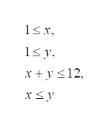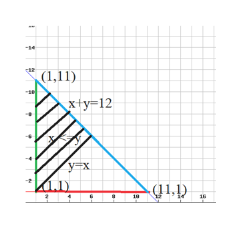A florist sells blue and green daisies. Due to different membership cards, Patty and Dmitri pay according to the following table.Blue GreenPatty £1.25 £2.00Dmitri £2.75 £2.00Assume that both customers purchase x blue daisies and y green ones. Solve for x and y the linear programming problem which arises if we wish to maximize the total amount spent, subject to the constraints: at least one flower of each color must be bought, the total number of flowerspurchased cannot exceed twelve, and the number of green daisies bought must be at least as many as the number of blue ones bought.
A florist sells blue and green daisies. Due to different membership cards, Patty and Dmitri pay according to the following table.
Blue Green
Patty £1.25 £2.00
Dmitri £2.75 £2.00
Assume that both customers purchase x blue daisies and y green ones. Solve for x and y the linear programming problem which arises if we wish to maximize the total amount spent, subject to the constraints: at least one flower of each color must be bought, the total number of flowers
purchased cannot exceed twelve, and the number of green daisies bought must be at least as many as the number of blue ones bought.
To convert the given word problem into a linear programming model as per the data given.
The given conditions translate to the inequalities shown: (x blue daisies and y green ones)

The region defined by these inequalities is shown ; it is the region bounded by the green, blue and the black line (y=x)

Step by step
Solved in 6 steps with 5 images









